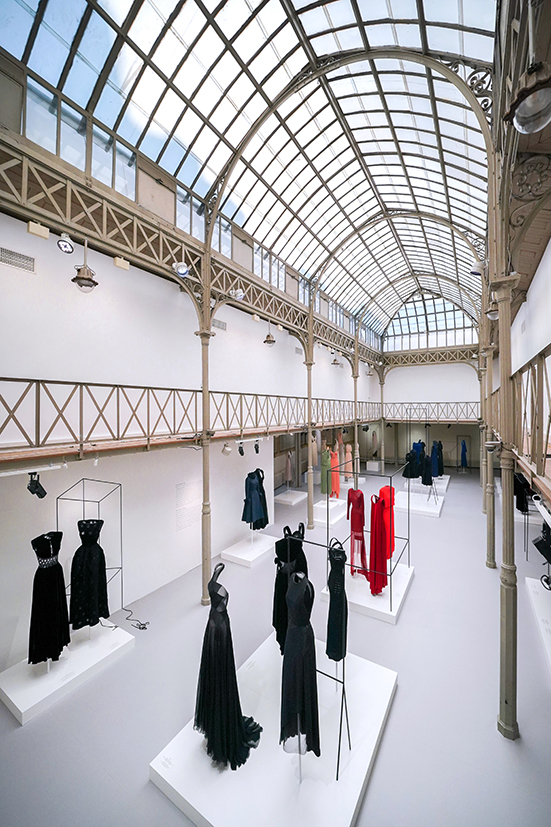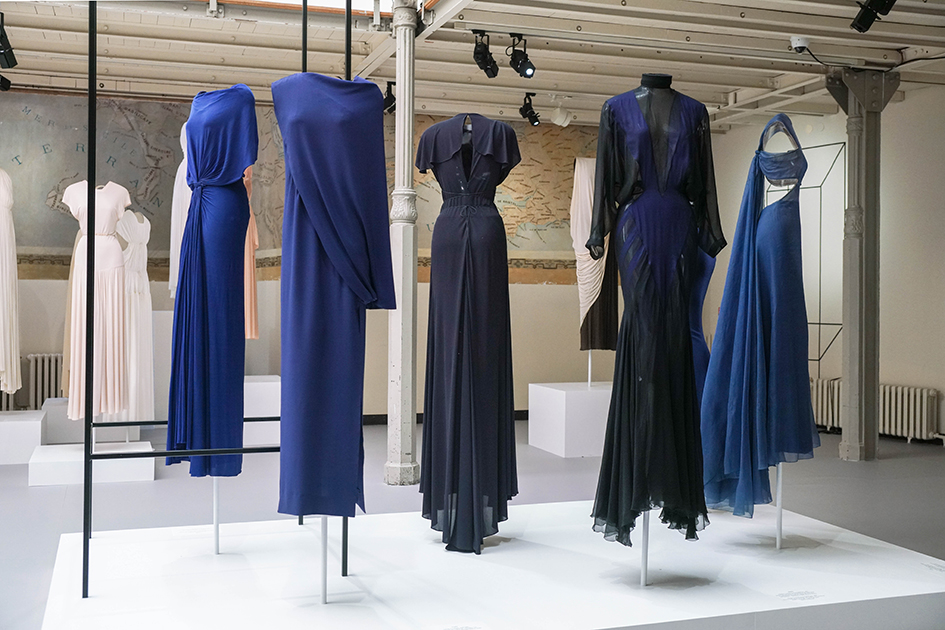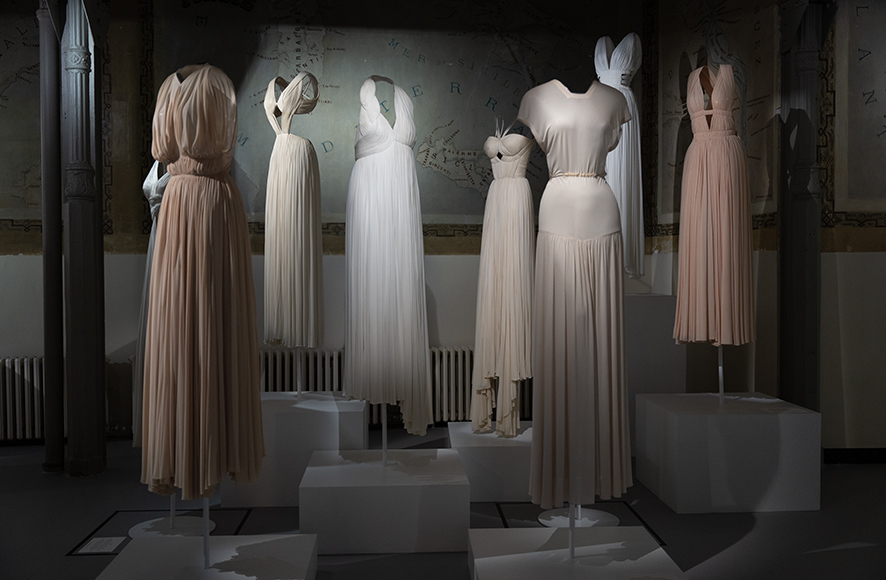Alaïa / Grès. Beyond Fashion

Alaïa / Grès. Beyond Fashion ph. Stéphane Aït Ouarab
Silent and secretive, determined to a lifetime of seclusion spent entirely in the workshop, Madame Grès (1903-1993) saw herself as a sculptor. Fully immersed in his work, with the relentless determination of tireless masters, and refusing the media excesses of his profession, Azzedine Alaïa (1935-2017) also studied sculpture at the School of Fine Arts in Tunis. This shared ambition was not corrupted by the fashion trades to which they dedicated themselves with such singularity and success. On the contrary, it elevated the art of draping for one and the art of cutting for the other to the level of guiding principles in the history of fashion.
While there is no evidence that the two couturiers ever crossed paths, their creations undoubtedly did. Apostles of a certain form of simplicity, the seemingly simple creations of Grès and Alaïa hide an inherent complexity in their cut and design. Guided by the fabric that governs their designs and choices, carefully collected for weeks in the decision-making process of shaping a dress, and assured in their selection of monochromatic colors, with a preference for intense black and plaster white, the two couturiers embraced a community of creation and spirit.
The drapery that Grès had elevated to the level of total art since the 1930s is embodied in Alaïa's long, fluid, and pleated dresses. The jersey embraced by the former translates into knitwear and soft materials in the latter's designs. The pursuit of proportion and the precision in cutting, whether for evening or daytime models, unite them.
"Once you find something that is personal and unique," confessed Madame Grès, "you must fully exploit it and pursue its realization without stopping, until the very end." To this, Alaïa later responded, "When an idea imposes itself on you, you have to lasso it, turn around it, and never deviate from it."
For the first time, an unprecedented exhibition brings together the works of Madame Grès and Alaïa. United by their formal principles, their cutting techniques, and the harmonious combinations of fabric and colors they commonly embraced, the evening gowns and day dresses by both couturiers invite visitors to a lesson beyond fashion. Timeless for one, and outside of time for the other, the exhibited creations, totaling 60, restore the dialogue between Grès and Alaïa, two solitary and determined individuals who became sculptors of dresses.

Alaïa / Grès. Beyond Fashion ph. Stéphane Aït Ouarab
Madame Grès, whose real name was Germaine Krebs, began working in the 1930s. In 1933, on rue de Miromesnil in Paris, she joined forces with Julie Barton to open the house Alix Barton, which became Maison Alix in 1934 on rue du Faubourg-Saint-Honoré. She quickly achieved great success with her designs reminiscing of antique statuary and at the same time perfectly adapted to modern life thanks to her own draping technique. Following disputes with her associates, Germaine Krebs founded the house Grès in 1942, an anagram of her husband Serge's first name. She established the white salons of her house and its workshops at 1 rue de la Paix, right in the heart of Paris. Indifferent to the trends and fads of the decades, Madame Grès presented her timeless collections here until 1987. Among her famous clients were Greta Garbo, Marlene Dietrich, Maria Casares, Delphine Seyrig, and Grace Kelly.
Azzedine Alaïa, Franco-Tunisian couturier, has created an exceptional body of work in the fashion industry, earning him his reputation as one of the most talented designers of his generation.
Upon his arrival in Paris in 1956, Azzedine Alaïa worked as a couturier for a private clientele. He was particularly influenced by the timeless elegance of some of his clients, such as Louise de Vilmorin, Arletty, Simone Zehrfuss, Cécile de Rothschild or Greta Garbo.
He presented his first ready-to-wear collection in 1982. He always remained closely connected to women, some of whom became his muses, including Grace Jones and Tina Turner. He also contributed to launching the careers of several models, including Naomi Campbell, Farida Khelfa, Stephanie Seymour, Tatjana Patitz, Cindy Crawford, and Veronica Webb.
Alaïa is one of the last couturiers to master every stage in the design and production of a garment. A master of cut and a worthy successor to the couture masters, he is also a great collector, having acquired over 15,000 pieces, bearing witness to the creations of fashion history in the 19th and 20th centuries. These include 700 dresses by Madame Grès now owned by the foundation that he wished for. A selection of models and photographs are being presented for the first time in the exhibition spaces.
Alaïa / Grès.Beyond Fashion - video Stéphane Aït Ouarab

Alaïa / Grès. Beyond Fashion ph. Stéphane Aït Ouarab

Alaïa / Grès. Beyond Fashion ph. Sylvie Delpech
Order the catalogue:
GUIDED TOURS OF THE EXHIBITIONS
The Foundation offers guided tours of the current exhibition at 18 rue de la Verrerie in partnership with the cultural mediation agency Des Mots et des Arts which organizes tours led by professionals specializing in fashion history. They offer visitors an overview of the current exhibition, the life and work of Azzedine Alaïa, as well as the location’s history and architecture.

Alaïa / Grès. Beyond Fashion ph. Stéphane Aït Ouarab
Until 21 January 2024, Azzedine Alaïa is back in the spotlight at the Palais Galliera with an exhibition showcasing the remarkable heritage collection he amassed over the years, and which has never been exhibited before.
Tariff partnership :
Visitors with an Azzedine Alaïa Foundation ticket will benefit from a reduced rate of €13 at the Palais Galliera.
Visitors with a ticket for the Palais Galliera will also benefit from a reduced rate of €7 at the Azzedine Alaïa Foundation.
Palais Galliera, musée de la Mode de Paris, 10 Avenue Pierre 1er de Serbie, 75016 Paris


